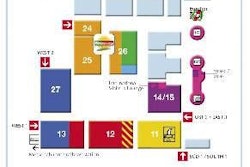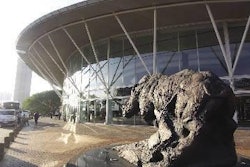Markets push prices for the main grains
We face a rough ride for feed costs over the next 12 months. Soon after watching the rapid rise in protein material prices, we have had to endure a price explosion for grains on the international market. During the month of October the steep increase in world grain prices took them to levels last seen in 1995/96, commented the International Grains Council. This was due entirely to an outburst of concern among traders about global supplies as crop prospects deteriorated. Wheat was a particular worry in terms of supply to meet likely requirements over the next year, said the council at the time, although the rest of us might say since that maize (corn) turned out to be no less worrisome.
Maybe some IGC numbers will add a perspective. The most recent market assessments from the council have suggested that about 585 million metric tons of wheat will be produced worldwide in the crop year to June 2007, compared with 618 million tons last time. World maize production is forecast at 690 million tons, down from 693 million tons. The barley harvest looks to have given around 140 million tons, much the same quantity as in 2005/06.
It would seem a little early to panic, on these predictions. Even more, other forecasters believe that less grain will be needed for animal feeds over the coming months until the middle of 2007 and human food's grain needs will show little change. Two factors in particular seem to have accounted for the traders' reaction, however. One was the corn crop from the USA, the other was the wheat harvest in Australia.
These are major exporters of grain to the feed and food producers of the world, of course. So it must hit prices when the expectations for US maize volumes are trimmed by 5 million tons or more and Australia is expected to produce only half of its usual annual wheat output. Carryover stocks are sure to be reduced below the levels seen in most years. Nevertheless, the sudden and explosive increase in the world market price of the main grains could yet prove to have been an over-reaction.
Dryness emphasises new water issues
A recent newspaper report in Australia underscored the extremely dry conditions that the country has been experiencing. One of the biggest pig units in the area was faced with finding other water sources for survival after its allocation from aquifer reserves was almost halved by a government agency. As the manager said, however, buying water elsewhere at an affordable price would be difficult given the existence of the drought nationally.
A few years ago I attended a meeting where the featured speaker presented his idea of the main attributes that countries must have to be competitive in pork production. His list went through grain supplies, availability of labour, proximity of consumers and a few other must-haves, but anyone attempting a similar analysis today would certainly need to include water. On my recent visit to one of the biggest pig-producing members of the European Union, I found producers worrying about water availability and what it might mean for the future of their business.
Whether Australia's drought is another sign of global climate change, it seems set to change international trading patterns. We are used to the exporting of Australian wheat around the globe. Now the country is shaping to become an importer of grains. An infrastructure for importing has been started and the applications to receive the first shipments were being processed by government officials in recent weeks.
Phosphorus limits may affect the legs
Environment-friendly feeding in the growing and finishing stages can take various forms, but the general theme is commonly to cut back on the pigs' excretion of phosphorus. Enzymes and others are used in limiting the amount of inorganic phosphorus that needs to be added to the feed as compensation for the inefficiency of the pig at digesting the phytate form present in vegetable ingredients. Anyone with Internet access on their computer can find thousands of references these days from a search of entries about phosphorus for pigs. Many of them contain salutary reminders that we tend to forget, such as that the organic phosphates bound in phytic acid represent over two-thirds of all phosphorus in plant sources. The pollution problem arises because although they are largely untouched by the pig's digestive system and are therefore excreted in the manure, they can be released by the action of natural microbes in the soil.
What is more, the Internet searches confirm a fact we should all know anyway. While the most expensive nutrients present in feeds for pigs are energy and protein, the third on the list for cost is phosphorus. Consequently, feeding less should open the way to saving a valuable slice of feed costs.
The most popular actions in practice involve adding phytase to release the organic phosphates and adjusting the phosphorus content of the diet according to the production stage. Taking account of the phytate issue, we also formulate feeds on the basis of available phosphorus rather than total content.
Knowing availability in terms of the full range of possible feed ingredients has come under discussion again recently. The experts warn that although the most widely used grains have been characterised, the amount of phosphorus available in some other, less common feedstuffs is not known so precisely. Formulators may be working on values that are not always correct.
Too much phosphorus in the feed would be costly and potentially polluting. But the risk being identified increasingly is at the other end of the scale, where the provision of the mineral has been substantially less than the pig requires. There seems to be a suspicion, if not outright evidence, that certain environment-friendly feeding practices have been responsible for an under-supply of phosphorus that has left the pigs susceptible to problems with feet and legs.
Ranking the breeds at the semen centre
A chance remark by the operator of an AI centre raised the question of the differences between boar breeds for their ease of use in semen collection. Nominal rankings suggested by this operator's own long experience are given here, but I would be interested to hear what you think. Obviously there is a confusing factor anyway, in that characteristics vary according to the breed specimen's country of origin and many centres supplying boar semen for artificial insemination work with synthetic purebreds from genetic improvement programmes.
Setting such cautionary notes aside, this operator reckoned the easiest breed on handling and semen delivery was the Large White. Presumably the Yorkshire would go into the same category. Next in line is the Berkshire, he said, then Pietrain, Landrace, Duroc and Hampshire.
The last pair would be the most contentious, of course. He rated Duroc lowly for its lethargic tendencies and occasionally poor semen volume. Hampshire would be everyone's idea of the most difficult breed of boar for AI, he claimed, because of a mixture of temperament and ejaculate quality. Yet most people are likely to agree that a Hampshire-Duroc is a sexual athlete that does well at boar studs. It demonstrates the adage that crossbreds are almost invariably more vigorous than purebreds, he continued. Given a free choice, the person put in charge of collecting semen for pig AI would do well to choose a crossbred boaror, failing that, a purebred Large White.
Not quite a new disease
Our report this month about PRRS has an American slant. In North America it is normal for the acronym of the disease to be pronounced as "purrs", rather like the sound of a cat.
I remind you of this in order to explain something that made me smile when I saw it. The directors of a well-known US pork company had opened a telephone conference with business analysts after the latest publication of financial results. As usual, someone was delegated to transcribe the conversations so the transcript could be made available afterwards to journalists and investors. In keeping with usual practice, too, the person doing the transcribing evidently had more skills in communications than in pig terminology.
That lack of background knowledge probably was responsible for an enjoyable misunderstanding in this case. One of the analysts was asking a director about current pig health issues facing the company's Midwest operations. Specifically, he is said by the transcribed notes to have asked: "Do you have any trouble with perzadol?"
My first reaction on reading this was to imagine there was some new pig disease out there which I had failed to notice. It took me several seconds at least to realise that the question had really been: "Do you have any trouble with PRRS at all?"PIGI
















